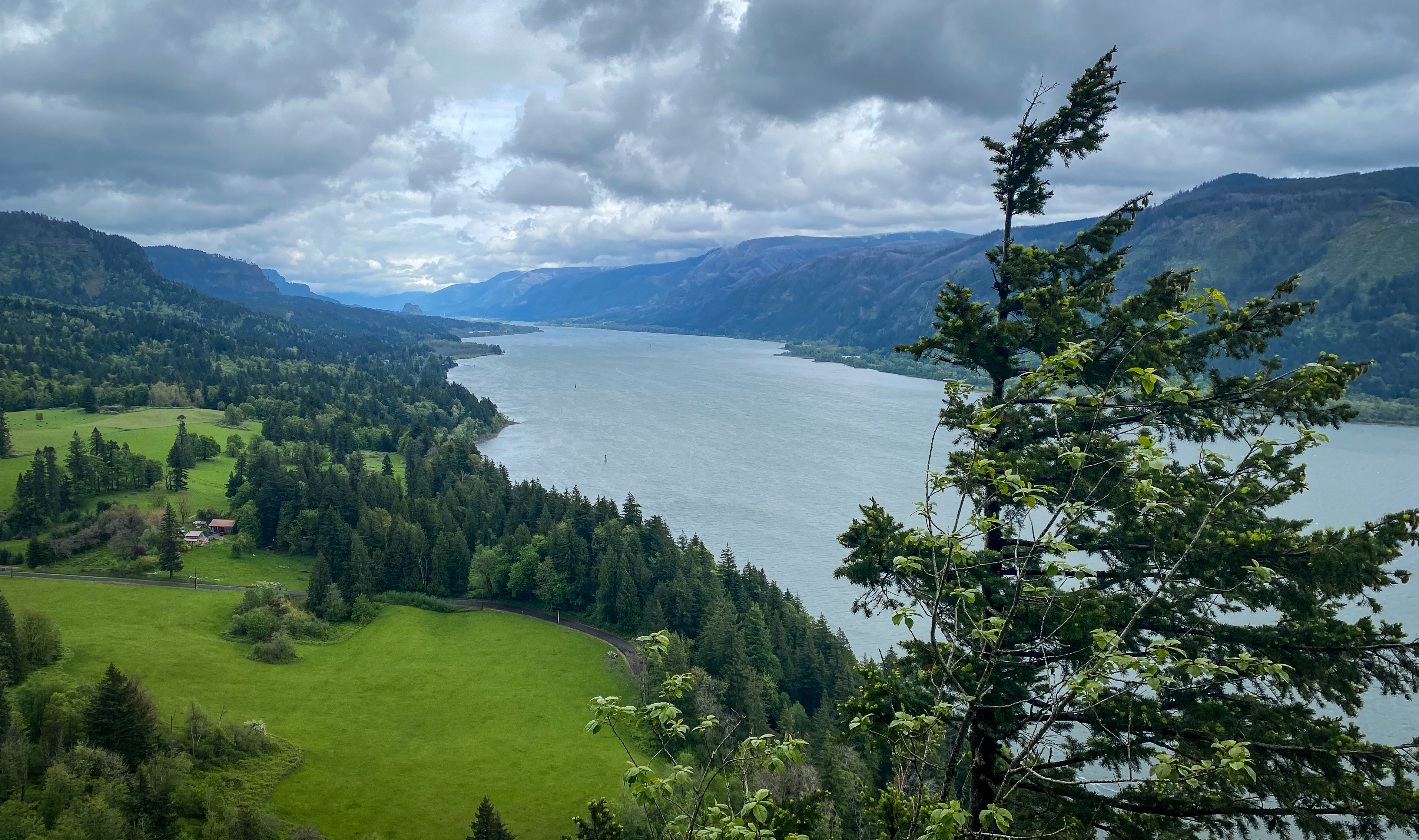
Southwest - Region 5
Customer service staff in the Ridgefield Regional Office are available for walk-in service 9 a.m. to 4 p.m. Monday through Friday excluding legal holidays.
The Cowlitz Wildlife Area field office in Morton is open to the public Monday through Friday 8 a.m. to 12 p.m., excluding legal holidays. This office now sells licenses and Discover Passes, and supports pelt sealing.
5525 S 11th Street
Ridgefield, WA 98642
United States
Fishing tips and news
New to fishing in Washington? Check out our Fish Washington blog post for a guide on how to get started.
2023-24 Sport Fishing Rules
The 2023-24 Washington Sport Fishing Rules pamphlet is available online and at hundreds of license dealers around the state. The updated rules can help anglers make decisions about how to spend their time on the water.
Current fishing regulations and emergency Fishing Rule Changes are also available online at wdfw.wa.gov/fishing/regulations.
Purchase your 2024 fishing license
Now that spring has arrived, Washingtonians will need to purchase 2024-2025 recreational hunting and fishing licenses effective April 1. Licenses can be purchased from WDFW’s licensing website, and from hundreds of license vendors around the state.
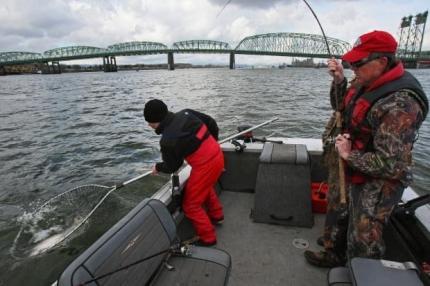
Lower Columbia River salmon and steelhead fishing
The spring Chinook salmon season will be open from April 1 through May 2 in waters above Bonneville Dam, extending from the Tower Island power lines (approximately six miles below The Dalles Dam) upstream to the Washington/Oregon border. Bank angling by hand-cast only is permitted between Bonneville Dam and the Tower Island power lines.
The daily limit is six, including no more than two adults, of which no more than one may be an adult Chinook. Anglers must release all wild steelhead and all salmon other than hatchery Chinook. The salmon must be 12 inches minimum to keep.
Learn more about managing Columbia River salmon in our latest blog post.
Meanwhile, spring Chinook fishing is open through April 5 from the Buoy 10 line upstream to Beacon Rock (boat and bank), plus bank angling by hand-cast only from Beacon Rock upstream to the Bonneville Dam deadline under those same rules.
The spring Chinook run usually peaks in April and May. Fishery managers will monitor the fisheries, dam counts, and hatchery returns in-season and adjust as necessary. The run-size update typically occurs in mid-May.
Fishing the tributaries
Spring Chinook and steelhead fishing in most lower Columbia River tributaries is open. However, based on preseason forecasts, daily limits were reduced to one adult salmon in Drano Lake, and in the Wind, Kalama, Klickitat, and Cowlitz rivers. Adult salmon must be both adipose and ventral clipped for retention in the lower Cowlitz River.
Learn about changes to Lewis River steelhead production in a recent blog post.
For recent catch reports, see our Southwest Washington fishing reports webpage.
Anglers should review the Washington Sport Fishing Rules pamphlet for the water they plan to fish, as well as check the emergency rule changes before heading out. Regulations may be modified in-season as returns materialize.
Trout and kokanee fishing in lakes and ponds
While most lakes in southwest Washington are year-round, the lowland lakes trout fishing season begins April 27, offering more opportunity for anglers in the region.
WDFW hatchery personnel have been busy planting lakes with catchable trout ahead of the opening weekend. Lakes stocked with rainbow trout in March include:
- Horseshoe Lake, Silver Lake, and Lake Sacajewea in Cowlitz County
- Swofford Pond and South Lewis County Park Pond in Lewis County
- Battle Ground Lake, Lacamas Lake and Klineline Pond in Clark County
- Rowland Lake and Maryhill Pond in Klickitat County
- Icehouse Lake in Skamania County
The 2024 expected plant for Region 5 is 472,251 catchable trout; 93,000 put-and-grow; 13,320 jumbo; and 100,000 fry/fingerling. Planted trout will average 10 to 12 inches with some measuring 14- to 18-inches. For the full breakdown of recent and future statewide plants, please visit the trout stocking webpage.

Lowland lakes in the area that should produce opening weekend include Horsethief, Spearfish, and Rowland lakes in Klickitat County, and Carlisle and Mineral lakes in Lewis County. Anglers should be aware that Swift Reservoir in Skamania County does not open until May 25.
Lake Merwin and Yale Reservoir are producing kokanee at various depths, though anglers are advised to check the wind forecast before hitting the water.
Annual statewide trout derby
Opening day for lowland lakes on April 27 is also the kickoff of the Department’s annual statewide trout derby at more than 100 stocked lakes in Washington state. Over 100 participating businesses are offering more than 800 prizes valued at over $42,000.
The derby is open to anyone with a valid 2024 fishing license, though temporary licenses are not valid for game species from April 27 to May 1. There is no entrance fee or registration required. Simply catch a tagged trout anytime between April 27 and Oct. 31 and you win! Plus, children aged 14 and under fish for free.
Visit the derby information page in early April to find a participating lake near you and learn more about how the derby works.
Steelhead plants in area lakes
In addition to rainbow trout, several Southwest Washington lakes were stocked with steelhead in recent months, with plans to plant more. Recently planted lakes include:
- Kress Lake and Horseshoe Lake in Cowlitz County
- Fort Borst Park Pond in Lewis County
Planted fish will have a tag along their dorsal fin with a phone number for WDFW staff, who will track the program’s success.
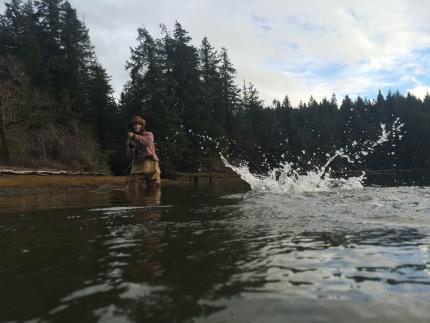
Trout fishing in rivers and streams
Cutthroat trout fishing is available in the Cowlitz River and other watersheds, see regulations for details. Native rainbow trout may also be encountered.
Warmwater fish
Crappie are moving in and out of the canals in Silver Lake, providing success for anglers willing to move around. Rowland Lake is also a good option for crappie, as well as bluegill and pumpkinseed. Yellow perch are active in Lacamas Lake. Largemouth bass are biting in Kress Lake and Carlisle Lake, while Riffe Lake has produced for smallmouth bass anglers. Those in pursuit of tiger muskie are finding action in Mayfield Lake, with expectations of Lake Merwin becoming more active in April.
Sturgeon fishing closed in Bonneville and Dalles pools
Sturgeon retention is closed from the Bonneville Pool upstream to McNary Dam through April 30. The Bonneville, Dalles and John Day pools remain open for catch-and-release fishing for sturgeon on days not open to retention, as do many other stretches of the Columbia River. Please check the emergency rules before heading out.
Participate in the annual North of Falcon salmon season setting process
Each year state, federal, and tribal fishery managers gather to plan the Northwest’s recreational and commercial salmon fisheries. This salmon-setting process is known as North of Falcon, which refers to Oregon’s Cape Falcon, the southern border of active management for Washington salmon stocks. Learn more about the process, upcoming virtual public meetings, and other opportunities to share your feedback on our website.
Boating safety
With freshwater fishing season openers in March and April, the Washington State Park and Recreation Commission Boating Program reminds you to take a boater safety education course, if you haven’t already, to be prepared for the season. In Washington, boaters who operate a vessel with a 15-horsepower engine or greater must carry a Boater Education Card to prove they passed an accredited boating safety education course.
Hunting tips and news
For an overview of hunting in Washington and how to get started, visit our Hunt Washington blog post.
2023-24 Hunting Regulations
The 2023-24 Game Bird and Small Game Hunting Regulations and Big Game Hunting Regulations pamphlets are available online and at hundreds of license dealers around the state. The updated rules can help hunters make decisions about how to spend their time in the field.
Current hunting regulations are also available online at wdfw.wa.gov/hunting/regulations.
Wild turkey hunting

Spring turkey hunting kicks off with the youth-only season from April 1 through April 7, followed by the general spring turkey season for hunters of all ages. The general spring turkey season runs April 15 through May 31. See WDFW’s Wild Turkey Spring Season hunting regulation pamphlet for more information.
In the Southwest region, Klickitat County is the most popular area to find and hunt wild turkey. WDFW provides public hunting opportunity on both Wildlife Area lands and private lands enrolled in the Private Lands Access Program. For more details including a list of available properties to hunt, visit the Private Lands Hunting Access webpage.
Special hunt applications now available
Multi-season deer and elk tags enable you to hunt archery, muzzleloader, and modern firearm seasons, while special hunt permits offer opportunities such as hunting outside general seasons, all increasing your chances for success. Learn more including details on the May 15 special hunt application deadline on myWDFW.com.
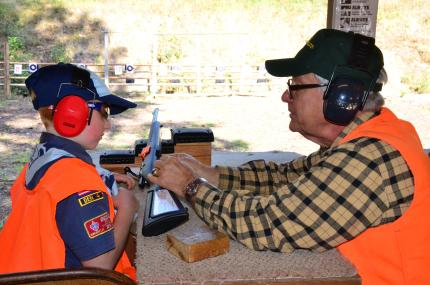
Sign up for in-person hunter education
Hunter education is a mandatory program designed to promote knowledge and skills to continue our proud hunting tradition. WDFW offers two types of hunter education courses that teach firearms and outdoor safety, wildlife management, and hunter responsibility. All hunters born after Jan. 1, 1972 must show proof of hunter education course completion before purchasing their first Washington hunting license. For more information, visit the Hunter Education web page.
Morton office opens to the public
WDFW is pleased to announce that our office in the City of Morton is now open to the public. Office hours are Monday through Friday 8 a.m. to 12 p.m., excluding legal holidays. Previously, the office was only open by appointment. The office will be able to assist with fishing and hunting license sales, Discover Pass sales, local access information, and pelt sealing. Learn more in our recent news release.
Head to myWDFW.com for info on hunting, angling, and more
WDFW has rolled out a promotional website for all things hunting, angling, foraging, recreating, and more. At myWDFW.com, you’ll find informative how-to articles on the season’s major fishing and hunting opportunities, as well as a portal to online license sales and a regular update on WDFW’s latest Life Outdoors articles.
Each quarter, new fishing and hunting highlights are posted to help you get ready and take part in Washington’s current and upcoming opportunities. Dedicated to current agency promotions, outdoor recreation information, and educational content, myWDFW.com preps you to meet with success in the field and on the water.
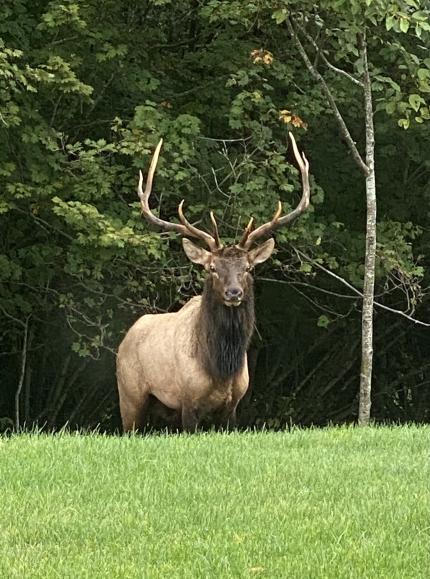
Hoof disease in elk
As many hunters know, Treponeme-Associated Hoof Disease (TAHD) has spread among elk in Western Washington in recent years. While elk are susceptible to many conditions that cause limping or hoof deformities, the prevalence and severity of this new affliction – now known as treponeme-associated hoof disease (TAHD) – suggests something different.
In 2021, WDFW implemented an incentive-based pilot program to encourage Western Washington (400, 500, 600 series GMUs) hunters to harvest limping elk, potentially reducing prevalence of the disease over time. General season or permit hunters can choose to participate in the program by submitting elk hooves at one of the many collection sites in western Washington.
See the WDFW website for the locations of collection sites. Hunters that submit hooves with signs of TAHD (for example, abnormal hooves) will be automatically entered into a drawing for a special incentive permit for the following license year. Multiple bull permits in western Washington with season dates of Sept. 1 – Dec. 31 will be awarded. Additionally, all participants will receive a custom, waterproof license holder.
What hunters can do to help:
- Harvest a limping elk from any 400, 500, 600 series GMUs.
- Turn in your elk hooves along with complete registration forms at one of several collection sites in western Washington.
- Report elk: Hunters can help WDFW track TAHD by reporting observations of both affected and unaffected elk on the department’s online reporting form.
- Clean shoes and tires: Anyone who hikes or drives off-road in a known affected area can help minimize the risk of spreading the disease to new areas by removing all mud from their shoes and tires before leaving the area.
Wildlife viewing and recreation
Searching for places to watch wildlife or recreate on State Wildlife Areas or WDFW Water Access Areas? Visit our Places to Go webpage, Wildlife Area map or Water Access Area webpage for ideas.
Or visit our wildlife viewing webpage for more information and tips on wildlife watching!

Leave wild babies wild
April is a busy month for the birth of baby animals. If you find fawns, baby birds, or other young animals, please leave them be, even if they appear to be orphaned or abandoned. Most animals have a parent foraging or hunting nearby. Read our blog to learn about when not to rescue wildlife and what to do if you encounter certain species.
For wildlife that do require care, WDFW relies on permitted rehabilitators. Rehabilitators are trained and highly skilled in providing the unique attention needed for injured or orphaned wildlife, and care deeply for the animals entrusted to them.
Visit our website to learn more about Washington’s wildlife rehabilitators and find one near you. Remember to thank the rehabilitators in your region for the important work they do on behalf of our state’s wildlife!
Practice bear awareness this spring
Black bears are common throughout Washington, including suburban areas. Both when preparing for hibernation and awakening from it, they look for high-calorie foods that are easy to obtain. These may include garbage, bird feeders (both seed and liquid), fruit trees, and pet food.
As human populations encroach on bear habitat, people and bears have greater chances of encountering each other. Food sources provided by humans, whether intentionally or not, can attract bears. Removing these attractants is the best way to encourage bears to move along and focus on natural food sources.
Ask your local waste management company if bear-resistant containers are available or if individually purchased bear-resistant containers are compatible with the company’s equipment. Secure your garbage cans, such as in a shed or garage, and put them out the morning of pickup — not the night before. To help reduce odors, freeze meat and fish waste before disposing of it and spray garbage cans with disinfectants.
More information on living with bears is available on our website and our blog.
Sandhill cranes
As spring approaches, sandhill cranes are making their way to the Vancouver lowlands for their annual mating ritual. Thousands of these majestic birds, with wingspans of up to seven feet, will flock to key feeding grounds, including the Ridgefield National Wildlife Refuge, before embarking on their journey northward.
The cranes have plenty of company while they’re in the area. Great egrets, tundra swans, belted kingfishers and a wide variety of other birds are also arriving for spring.
Conserving species and habitats
Looking for more info on wildlife conservation and species management around Washington? Check out our Bi-Weekly Wildlife Program reports.
Check out our January/February 2024 Director's Bulletin for more conservation highlights!
Wild Washington Youth Education program
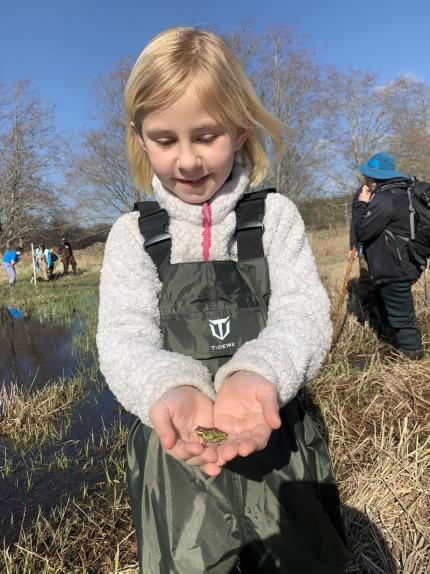
Monday, April 22 is the 54th annual Earth Day. Earth Day is a great way to celebrate our planet and the services it provides like clean air, clean water, pollution control, and food to eat. It’s also a great time to give back to our planet through volunteering. Check out official Earth Day events throughout Washington or Earth Day events WDFW is attending on our calendar (many events are taking place on Saturday, April 20 this year). You can also celebrate Earth Month with your family through WDFW family educational resources focused on stewardship. These resources are a great way to become a fish and wildlife steward right in, or near, your home.
Submit comments on bald eagles, peregrine falcons
WDFW is seeking public input on its draft periodic status reviews for the bald eagle and peregrine falcon.
Both species have previously been removed from Washington’s list of state endangered species due to population recovery in the state. Based on the latest available information, WDFW biologists recommend that both birds retain their status as successfully recovered.
The public comment periods for the bald eagle and peregrine falcon draft status reviews are open through May 27. The Washington Fish and Wildlife Commission is tentatively scheduled to consider these topics in June. Learn more in our news release.
Join the WDFW team
If you’d enjoy preserving, protecting, and perpetuating the state’s fish, wildlife, and ecosystems while providing sustainable fish and wildlife recreational and commercial opportunities, then check out some of our current job openings or sign up for job alerts. From fishery technicians and environmental planners to data scientists, archaeologists to wildlife biologists, a career with WDFW makes a difference.
Volunteer opportunity spotlight
WDFW welcomes volunteers of all abilities who want to contribute to the conservation of fish, wildlife, and habitat. Diverse volunteer opportunities are available, including projects on state wildlife areas and water access areas, habitat restoration projects, Hunter Education instruction, and assisting at outreach events.
For more information about the volunteer program and upcoming volunteer opportunities, visit the WDFW volunteer webpage.
Meet your Regional Director: Rian Sallee

Rian Sallee has worked in the non-profit, private and government sectors on environmental protection and conservation, specializing in water quality policy. She joined WDFW in 2022 from the Washington State Department of Ecology where she led the Vancouver Field Office with a focus on environmental justice and diversity, equity, and inclusion.
Rian is honored to serve WDFW as Region 5 Director. She looks forward to co-creating a culture of belonging at the agency informed by our shared values and the legacy of the exceptional work and dedication of our employees. She is motivated to collaborate internally between regions and across programs, and externally to support our partnerships. Rian enjoys working at the intersection of people, science and policy and is excited to connect with and learn from our employees throughout the state as they work to conserve Washington’s fish, wildlife and the habitats that support them.
Rian serves as Vice-Chair of the Board of the Lower Columbia Estuary Partnership. She is from the Midwest and spent years living and working on Lake Erie which instilled in her a passion for and commitment to natural resource conservation and environmental protection. She holds a Master of Environmental Science degree from Miami University in Ohio.